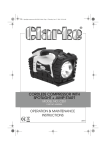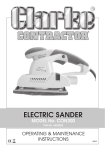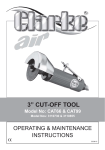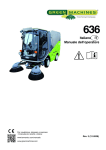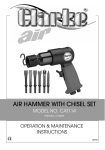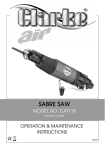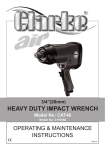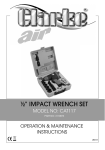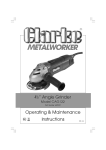Download Clarke CON100 Specifications
Transcript
RECIPROCATING SAW Part No. 6460200 MODEL No. CON100 Part No. 6459000 OPERATING & MAINTENANCE INSTRUCTIONS LS0610 1 Thank you for purchasing this CLARKE Reciprocating Saw. Before attempting to use the reciprocating saw, please read this manual thoroughly and follow the instructions carefully. In doing so you will ensure the safety of yourself and that of others around you, and you can look forward to the reciprocating saw giving you long and satisfactory service. GUARANTEE This product is guaranteed against faulty manufacture for a period of 12 months from the date of purchase. Please keep your receipt which will be required as proof of purchase. This guarantee is invalid if the product is found to have been abused or tampered with in any way, or not used for the purpose for which it was intended. Faulty goods should be returned to their place of purchase, no product can be returned to us without prior permission. This guarantee does not effect your statutory rights. FEATURES • Variable speed reciprocating saw • 3 stage pendulum action SPECIFICATIONS Model number ................................................... CON100 Rated voltage ................................................... 230V AC 50Hz Input power ....................................................... 600 Watts No load variable speed ................................... 700 - 2300 strokes per minute Pendulum action .............................................. 3 stage Cutting capacities ............................................ Metal - 10 mm ............................................................................. Wood - 150 mm Sound pressure level ......................................... 95.02 dB (A) Sound power level ............................................ 106.02 dBLwA Please note that the details and specifications contained herein, are correct at the time of going to print. However, CLARKE International reserve the right to change specifications at any time without prior notice. 2 GENERAL SAFETY PRECAUTIONS WARNING: As with all machinery, there are certain hazards involved with their operation and use. Exercising respect and caution will considerably lessen the risk of personal injury. However, if normal safety precautions are overlooked or ignored, personal injury to the operator or damage to property, may result. 1. 2. 3. 4. 5. 6. 7. 8. 9. 10. 11. 12. 13. 14. 15. ALWAYS Learn the machines’ applications, limitations and the specific potential hazards peculiar to it. Read and become familiar with the entire operating manual. ALWAYS use a face or dust mask if operation is particularly dusty. ALWAYS check for damage. Before using the machine, any damaged part, should be checked to ensure that it will operate properly, and perform its intended function. Check for alignment of moving parts, breakage of parts, mountings, and any other condition that may affect the machines’ operation. Any damage should be properly repaired or the part replaced. If in doubt, DO NOT use the machine. Consult your local dealer. ALWAYS disconnect the tool/machine from the power supply before servicing and when changing accessories. ALWAYS wear safety goggles, manufactured to the latest European Safety Standards. Everyday eyeglasses do not have impact resistant lenses, they are not safety glasses. ALWAYS keep work area clean. Cluttered areas and benches invite accidents. ALWAYS ensure that adequate lighting is available. A minimum intensity of 300 lux should be provided. Ensure that lighting is positioned that you will not be working in your own shadow. ALWAYS keep children away. All visitors should be kept a safe distance from the work area, especially whilst operating the machine. ALWAYS maintain machine in top condition. Keep tools/ machines clean for the best and safest performance. Follow maintenance instructions. ALWAYS handle with extreme care do not carry the tool/ machine by its’ electric cable, or yank the cable to disconnect it from the power supply . ALWAYS ensure the switch is off before plugging in to mains. Avoid accidental starting. ALWAYS concentrate on the job in hand, no matter how trivial it may seem. Be aware that accidents are caused by carelessness due to familiarity. ALWAYS keep your proper footing and balance at all times don’t overreach. For best footing, wear rubber soled footwear. Keep floor clear of oil, scrap wood, etc. ALWAYS wear proper apparel. Loose clothing or jewellery may get caught in moving parts. Wear protective hair covering to contain long hair. ALWAYS use recommended accessories. The use of improper accessories could be hazardous. 3 GENERAL SAFETY PRECAUTIONS 16. 17. 18. 19. 20. ALWAYS remove plug from electrical outlet when adjusting, changing parts, or working on the machine. NEVER operate machine while under the influence of drugs, alcohol or medication. NEVER leave machine running unattended. Turn power off. Do not leave the machine until it comes to a complete stop. NEVER force the machine. It will do a better and safer job at the rate for which it was designed. NEVER use power tools in damp or wet locations or expose them to rain. Keep your work area well illuminated. Do not use in explosive atmosphere (around paint fumes, flammable liquids etc.). Avoid dangerous environments. ADDITIONAL WARNINGS FOR RECIPROCATING SAWS 1. 2. 3. 4. 5. 6. 7. 8. 9. 10. 11. 12. 13. 14. 15. ALWAYS wear ear protectors/defenders as the noise level of this machine can exceed 85dB (A). ALWAYS use the appropriate blade for the material being cut. ALWAYS keep the mains cable well away from the machine and ensure an adequate electrical supply is close at hand so that the operation is not restricted by the length of the cable. ALWAYS switch the machine OFF immediately the task is completed. ALWAYS ensure the blade is fully tightened before use. ALWAYS allow sufficient clearance beneath the work to ensure the blade does not come into contact with the floor, table etc. ALWAYS check for hidden electrical wires or water pipes etc. NEVER allow the ventilation slots in the machine to become blocked. DO NOT cut material above the specified thickness. DO NOT cut through walls or cavities before checking for hidden electrical wires or water pipes etc. DO NOT touch the blade immediately after use, allow time for it to cool. DO NOT cut work less than at least twice the pitch of the saw blade. i.e. at least two teeth must be in contact with the work at all times. DO NOT use the machine if the electric cable, plug or motor is in poor condition. When cutting wood, ensure all nails have been removed beforehand. Nails will damage the wood saw blade. When cutting metals, always use a cooling agent i.e. cutting/soluble oil. Additionally, please keep these instructions in a safe place for future reference. 4 ELECTRICAL CONNECTIONS This product is provided with a standard 13 amp, 230 volt (50Hz), BS 1363 plug, for connection to a standard, domestic electrical supply. Should the plug need changing at any time, ensure that a plug of identical specification is used. WARNING! This appliance is double insulated, and the two wires in the mains lead should be wired in accordance with the following colour code: BLUE - NEUTRAL BROWN - LIVE • Connect the BLUE coloured wire to the plug terminal marked with a letter “N” • Connect the BROWN coloured wire to the plug terminal marked with a letter “L” If this appliance is fitted with a plug which is moulded on to the electric cable (i.e. non-rewireable) please note: 1. The plug must be thrown away if it is cut from the electric cable. There is a danger of electric shock if it is subsequently inserted into a socket outlet. 2. Never use the plug without the fuse cover fitted. 3. Should you wish to replace a detachable fuse carrier, ensure that the correct replacement is used (as indicated by marking or colour code). 4. Replacement fuse covers can be obtained from your local Clarke dealer or most electrical stockists. FUSE RATING The fuse in the plug must be replaced with one of the same rating (5 amps) and this replacement must be ASTA approved to BS1362. If in doubt, consult a qualified electrician. Do not attempt any electrical repairs yourself. CABLE EXTENSION Always use an approved cable extension suitable for the power rating of this tool (see specifications), the conductor size should also be at least the same size as that on the machine, or larger. When using a cable reel, always unwind the cable completely. If using tool outdoors, only use extension cables intended for outdoor use. 5 BEFORE USE FITTING THE BLADE WARNING! Before removing, or installing a blade, make sure that the mains plug has been removed from the mains supply. Shoe adjustment screws 1. Loosen the blade securing screw, using the hexagonal key provided. 2. With the blade teeth facing downwards, push the blade shank into the blade locating clip as far as possible. 3. Fully tighten the blade securing screw. Blade securing screw ADJUSTING THE SHOE 1. The shoe can be adjusted by loosening the shoe adjustment screws and sliding the shoe in or out. 2. Re-tighten all screws before use. VARIABLE SPEED SELECTOR The variable speed selector is used to control the speed of the reciprocating saw. • The higher the number selected the faster the stroke rate of the blade. • The stroke rate should be changed according to the material being cut. This is only a recommendation, you should always make a test cut on a scrap piece of material first. MATERIAL Variable speed selector 6 RECOMMENDED SPEED SETTING Wood 5-MAX Metal 2-3 Aluminium 3-5 PVC 3-4 OPERATION ON/OFF SWITCH 1. Slide the trigger switch down and back. Trigger switch The saw will run at the speed selected with the variable speed selector. 2. To switch off the reciprocating saw, release the trigger switch. WARNING! The blade will continue to run for a short period after the trigger has been release. Wait until it stops before removing it from the workpiece. WARNING! If the cutting operation is dusty, we recommend that you use a dust mask. 7 OPERATION PENDULUM SWITCH The pendulum switch adjusts the cutting stroke for each type of material. This improves the quality of the cut, and increases the blade life. Position Wood Metal Plastics 3 Fast cuts - PVC 2 Thick workpieces - Fibreglass 1 Plywood Aluminium - Chipboard Non-ferrous - Thin Workpieces Sheet metal - Acrylic 0 Fine Cuts To adjust the pendulum setting 1. Rotate the pendulum switch to the desired setting. Use the table above to select the correct setting. Pendulum action switch 8 OPERATION TIPS Cutting wood • Clamp the workpiece securely and remove all nails and metal objects. • Holding the tool with both hands, work with the saw shoe pressed against the workpiece. Plunge cutting in wood • Rest the saw shoe on the workpiece in such a position that the blade forms an appropriate angle for the plunge cut. • Switch on the tool and feed the blade into the material at full speed, make sure that the saw shoe remains in contact with the workpiece at all times. Pocket cuts • Measure and mark the required pocket cut. • Using a narrow saw blade rest the bottom of the saw shoe on the workpiece and make sure that the blade is positioned on the cutting line. If necessary, e.g. in confined spaces, use the outer edge of the saw shoe as your guideline. • Switch on the tool and feed the blade into the material at full speed, holding the tool firmly against the workpiece. Cutting metal • When cutting thin metal always stabilize the workpiece with wood on both sides. This guarantees clean cuts and prevents damaging the material. • For long, straight cuts draw a line on the workpiece. • Apply a thin film of lubricant along the cutting line, switch on the tool and follow the cutting line. Cutting plastics • Always work at reduced speed. Carry out a test cut to check whether the material is sensitive to heat. 9 MAINTENANCE WARNING! Before performing any maintenance tasks make sure that the mains plug has been removed from the mains supply. • After use, clean all dust and wood chippings from the reciprocating saw. • Clean all of the ventilation slots on the motor housing. • Make sure that the shoe is free from dirt and grease. • Keep the handle clean and free from oil and grease. • Resin and glue on the blade causes poor cutting results. Clean the blade after use. • Refer to your CLARKE dealer if internal maintenance is required. REPLACEMENT BLADES Replacement blades are available from your CLARKE dealer. Please quote the following part numbers: Type Part Number Metal cutting blades (5 pk) 64 6 2 0 2 9 Wood cutting blades (5 pk) 6462028 Log cutting blades (5 pk) 6462027 10 PARTS DIAGRAM PARTS & SERVICE For Spare Parts and Service, please contact your nearest dealer, or CLARKE International, on one of the following numbers. PARTS & SERVICE TEL: 020 8988 7400 or e-mail as follows: PARTS: [email protected] SERVICE: [email protected] 11 PARTS LIST Available as a Spare part Description 1 KPCON10001 Tapping Screw Yes 32 KPCON10032 Screw Yes 2 KPCON10002 Spring Washer Yes 33 KPCON10033 Washer Yes Item Part Item Number Available as a Spare part Part Number Description 3 KPCON10003 Screw Yes 34 KPCON10034 Socket Head Screw Yes 4 KPCON10004 Cove Plate Assembly Yes 35 KPCON10035 Localising Pin Yes 5 KPCON10005 Blade Clamp Screw Yes 36 KPCON10036 Pendulum Selector Yes 6 KPCON10006 Blade Clamp Plate Yes 37 KPCON10037 Thimble Yes 7 KPCON10007 Copper Brushing Yes 38 KPCON10038 Spring Yes 8 KPCON10008 Shaft Yes 39 KPCON10039 Elestic Pin Yes 40 KPCON10040 Speed Reducuction Gearbox Yes 9 KPCON10009 Elastic Pin Yes 10 KPCON10010 Elastic Pin Yes 41 KPCON10041 Connecting Plate Yes 11 KPCON10011 Strongback Yes 42 KPCON10042 Switch Yes 12 KPCON10012 Bracket Yes 43 KPCON10043 Spring Yes 13 KPCON10013 Spring Yes 44 KPCON10044 Switch Yes 14 KPCON10014 Saw Holder Yes 45 KPCON10045 Left Enclosure Yes 15 KPCON10015 Shaft Holder Yes 46 KPCON10046 Circuit Plate Yes 16 KPCON10016 Spacer Sleeve Yes 47 KPCON10047 Quick Stop Ctrl Switch Yes 17 KPCON10017 Needle Roller Bearing Yes 48 KPCON10048 Wiring Terminal Yes 18 KPCON10018 Gyro Wheel Yes 49 KPCON10049 Capacitor Yes 19 KPCON10019 Pin Yes 50 KPCON10050 Stator Yes 20 KPCON10020 Gearing Yes 51 KPCON10051 Bearing Yes 21 KPCON10021 Washer Yes 52 KPCON10052 Brush Bearing Yes 22 KPCON10022 Balance Block Yes 53 KPCON10053 Carbon Brush Yes 23 KPCON10023 Lifting knife Plate Yes 54 KPCON10054 Brush Holder Yes 24 KPCON10024 Washer Yes 55 KPCON10055 Rotor Yes 25 KPCON10025 Guide Block Yes 56 KPCON10056 Bearing Yes 26 KPCON10026 Washer Yes 57 KPCON10057 Cord Sleeve Yes 27 KPCON10027 Fixing Ring Yes 58 KPCON10058 AC Cord + Plug Yes 28 KPCON10028 Rivet Yes 59 KPCON10059 Strain Relief Yes 29 KPCON10029 Connecting Plate Yes 60 KPCON10060 Tapping Screw Yes 30 KPCON10030 Shoe Yes 61 KPCON10061 Right Enclosure Yes 31 KPCON10031 Saw Blade Yes 12 VIBRATION EMISSIONS HAND-ARM VIBRATION Employers are advised to refer to the HSE publication “Guide for Employers”. All hand held power tools vibrate to some extent, and this vibration is transmitted to the operator via the handle, or hand used to steady the tool. Vibration from about 2 to 1500 hertz is potentially damaging and is most hazardous in the range from about 5 to 20 hertz. Operators who are regularly exposed to vibration may suffer from Hand Arm Vibration Syndrome (HAVS), which includes ‘dead hand’, ‘dead finger’, and ‘white finger’. These are painful conditions and are widespread in industries where vibrating tools are used. The health risk depends upon the vibration level and the length of time of exposure to it……in effect, a daily vibration dose. Tools are tested using specialised equipment, to approximate the vibration level generated under normal, acceptable operating conditions for the tool in question. For example, a grinder used at 45° on mild steel plate, or a sander on softwood in a horizontal plane etc. These tests produce a value ‘a’, expressed in metres per second per second, which represents the average vibration level of all tests taken, in three axes where necessary, and a second figure ‘K’, which represents the uncertainty factor, i.e. a value in excess of ‘a’, to which the tool could vibrate under normal conditions. These values appear in the specification panel below. Declared vibration emission value in accordance with EN12096 Measured vibration emission value - a: 13.90 m/s2 Uncertainty value - K: 1.5 m/s2 Highest measured reading in a single plane 26 m/s2 Values determined according to EN28622-1 13 VIBRATION EMISSIONS You will note that a third value is given in the specification - the highest measured reading in a single plane. This is the maximum level of vibration measured during testing in one of the axes, and this should also be taken into account when making a risk assessment. 2 ‘a’ values in excess of 2.5 m/s are considered hazardous when used for 2 prolonged periods. A tool with a vibration value of 2.8 m/s may be used for 2 up to 8 hours (cumulative) per day, whereas a tool with a value of 11.2 m/s may be used for ½ hour per day only. The graph shows the vibration value against the maximum time the respective tool may be used, per day. The uncertainty factor should also be taken into account when assessing a risk. The two figures ‘a’ and ‘K’ may be added together and the resultant value used to assess the risk. It should be noted that if a tool is used under abnormal, or unusual conditions, then the vibration level could possibly increase significantly. Users must always take this into account and make their own risk assessment, using the graph on the opposite page as a reference. Some tools with a high vibration value, such as impact wrenches, are generally used for a few seconds at a time, therefore the cumulative time may only be in the order of a few minutes per day. Nevertheless, the cumulative effect, particularly when added to that of other hand held power tools that may be used, must always be taken into account when the total daily dose rate is determined. 14 DECLARATION OF CONFORMITY When disposing of this product, ensure it is disposed of according to all local ordinances. It must not be disposed of with general household waste. 15
















